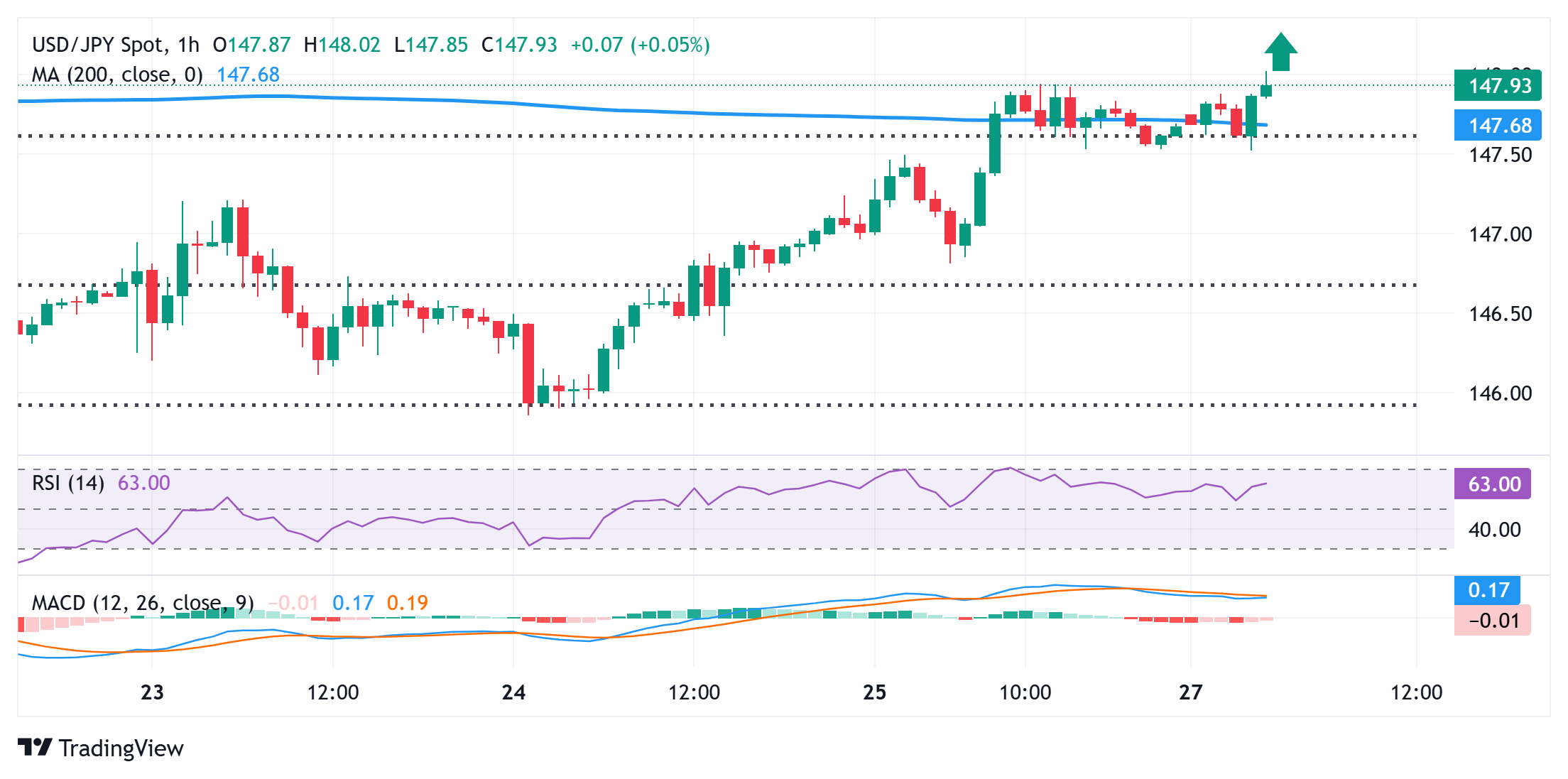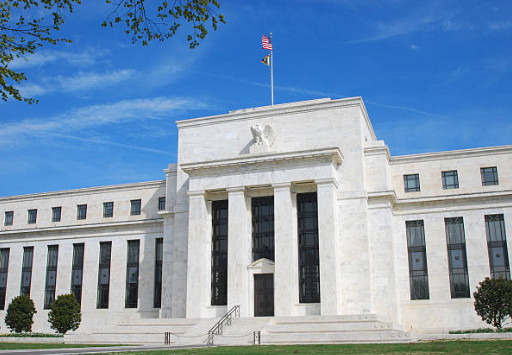Japanese Yen slides to one-week low against USD amid reduced safe-haven demand

- The Japanese Yen remains depressed on Monday amid the US-EU trade deal optimism.
- Diminishing odds for an immediate BoJ rate hike exert additional pressure on the JPY.
- Traders now seem reluctant ahead of this week’s central bank events and data risks.
The Japanese Yen (JPY) kicks off the new week on a softer note as the latest optimism over a trade deal between the US and the European Union (EU) undermines traditional safe-haven assets. Furthermore, reduced bets for an immediate interest rate hike by the Bank of Japan (BoJ), amid signs of cooling inflation in Japan and domestic political uncertainty, keep the JPY bulls on the defensive.
Meanwhile, Japan's trade deal with the US keeps the door open for an imminent BoJ rate hike this year, which, in turn, is seen acting as a tailwind for the JPY. This, along with subdued US Dollar (USD) price action, might keep a lid on any further gains for the USD/JPY pair. Traders might also refrain from placing aggressive directional bets and opt to wait for this week's key central bank events and data risks.
The US Federal Reserve (Fed) will announce its decision at the end of a two-day meeting on Wednesday, followed by the BoJ policy update on Thursday. Apart from this, US macro releases – the Advance Q2 GDP print, the Personal Consumption Expenditure (PCE) Price Index, and the Nonfarm Payrolls (NFP) report – will drive the US Dollar (USD) and provide a fresh impetus to the USD/JPY pair.
Japanese Yen pressured by risk-on mood, reduced BoJ hike bets, and political uncertainty
- News of a deal between the US and European Union on Sunday, and that US and Chinese officials are meeting again to extend the trade truce, add to the trade optimism ahead of the August 1 deadline. This, in turn, boosts investors' appetite for riskier assets and undermines demand for the safe-haven Japanese Yen at the start of a new week.
- Data released on Friday showed that consumer inflation in Japan's capital city, Tokyo, eased more than expected in July. Apart from this, rising political risks in Japan, especially after the ruling coalition's bruising defeat in the upper house election, might force the Bank of Japan to delay raising interest rates and keep the JPY bulls on the defensive.
- The US Dollar, on the other hand, preserves its gains registered over the past two days. This, in turn, assists the USD/JPY pair to attract buyers for the third straight day and climb above the 148.00 mark, or a one-week top during the Asian session. That said, a combination of factors might keep a lid on any further appreciating move for spot prices.
- Japan's trade deal with the US, announced last week, has reduced economic uncertainty and raised the possibility that the BoJ will resume its tightening cycle later this year, which, in turn, could act as a tailwind for the JPY. Traders might also opt to move to the sidelines ahead of this week's central bank event risks and key US macro releases.
- The Federal Reserve and the BoJ will announce their policy decisions on Wednesday and Thursday, respectively, and are widely expected to maintain the status quo. Investors, however, will look for cues about the future policy outlook, which, in turn, will play a key role in determining the next leg of directional move for the USD/JPY pair.
- Investors this week will also confront the release of important US macro data – the Advance Q2 GDP print on Wednesday, the Personal Consumption Expenditure (PCE) Price Index on Thursday, and the Nonfarm Payrolls report on Friday. This might further contribute to infuse volatility around the currency pair during the latter part of the week.
USD/JPY bulls gain control above 147.70-147.65 confluence resistance

From a technical perspective, last week's bounce from the 50% retracement level of the July upswing and a subsequent strength beyond the 200-hour Simple Moving Average (SMA) could be seen as a key trigger for the USD/JPY bulls. This, along with positive oscillators on daily/hourly charts, suggests that the path of least resistance for spot prices is to the upside. A sustained move and acceptance above the 148.00 mark will reaffirm the constructive outlook, which, in turn, should pave the way for additional gains towards last week's swing high, around the 148.65 region. The momentum could extend further and allow the pair to make a fresh attempt towards conquering the 149.00 mark.
On the flip side, the 100-hour SMA, currently pegged around the 147.70-147.65 area, which now coincides with the 23.6% Fibo. retracement level could offer support to the USD/JPY pair. Any further slide could be seen as a buying opportunity near the 147.00 mark and remain limited near the 146.70-146.65 region, or the 38.2% Fibo. retracement level. Some follow-through selling below the 100-day SMA, currently pegged near the 146.55 area, could make spot prices vulnerable to retest sub-146.00 levels. This is closely followed by the 145.75 area (July 10 low), below which the currency pair could slide to the 145.20-145.15 region, or the 61.8% Fibo. retracement level, en route to the 145.00 psychological mark.
Japanese Yen FAQs
The Japanese Yen (JPY) is one of the world’s most traded currencies. Its value is broadly determined by the performance of the Japanese economy, but more specifically by the Bank of Japan’s policy, the differential between Japanese and US bond yields, or risk sentiment among traders, among other factors.
One of the Bank of Japan’s mandates is currency control, so its moves are key for the Yen. The BoJ has directly intervened in currency markets sometimes, generally to lower the value of the Yen, although it refrains from doing it often due to political concerns of its main trading partners. The BoJ ultra-loose monetary policy between 2013 and 2024 caused the Yen to depreciate against its main currency peers due to an increasing policy divergence between the Bank of Japan and other main central banks. More recently, the gradually unwinding of this ultra-loose policy has given some support to the Yen.
Over the last decade, the BoJ’s stance of sticking to ultra-loose monetary policy has led to a widening policy divergence with other central banks, particularly with the US Federal Reserve. This supported a widening of the differential between the 10-year US and Japanese bonds, which favored the US Dollar against the Japanese Yen. The BoJ decision in 2024 to gradually abandon the ultra-loose policy, coupled with interest-rate cuts in other major central banks, is narrowing this differential.
The Japanese Yen is often seen as a safe-haven investment. This means that in times of market stress, investors are more likely to put their money in the Japanese currency due to its supposed reliability and stability. Turbulent times are likely to strengthen the Yen’s value against other currencies seen as more risky to invest in.






